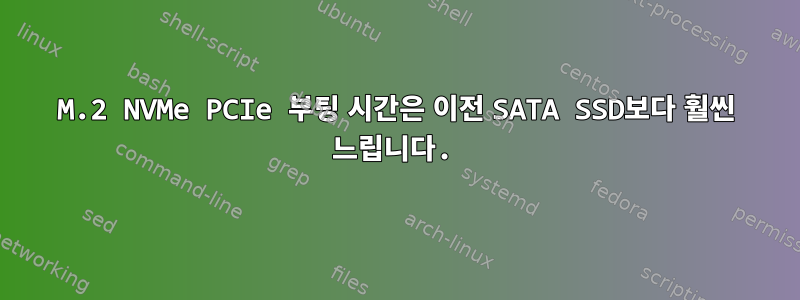
한번은 dd기존 SATA SSD를 Dell XPS 9360의 새로운 대형 NVMe 모델로 복제하고 SATA 구성을 원시 RAID에서 AHCI로 전환하여 부팅했습니다. 작동하지만 새 디스크는 특히 부팅 중에 이전 SSD보다 훨씬 느리게 느껴집니다. 이전에는 약 20초에 불과했던 기동 시간이 몇 분으로 단축되었습니다.
M.2 NVMe PCIe 칩의 경우 최상의 성능을 위해 AHCI 대신 SATA를 "비활성화"로 전환하라는 내용을 읽었습니다. 그렇습니까?
그렇다면 어떻게 모드를 안전하게 전환할 수 있나요? (BIOS에서 전환을 시도했지만 SSD가 인식되지 않아 부팅할 수 없습니다.)
AHCI를 계속 사용해야 한다면 부팅 시간을 어떻게 단축할 수 있습니까? (Fastboot는 BIOS에서 이미 활성화되어 있습니다)
원래 질문된 질문(그러나 주제에서 벗어난 것으로 간주됨)여기
창사:
$ sudo lshw
## output trimmed ##
*-pci:3
description: PCI bridge
product: Intel Corporation
vendor: Intel Corporation
physical id: 1d
bus info: pci@0000:00:1d.0
version: f1
width: 32 bits
clock: 33MHz
capabilities: pci pciexpress msi pm normal_decode bus_master cap_list
configuration: driver=pcieport
resources: irq:125 memory:dc200000-dc2fffff
*-storage
description: Non-Volatile memory controller
product: Toshiba America Info Systems
vendor: Toshiba America Info Systems
physical id: 0
bus info: pci@0000:3c:00.0
version: 01
width: 64 bits
clock: 33MHz
capabilities: storage pm msi pciexpress msix nvm_express bus_master cap_list
configuration: driver=nvme latency=0
resources: irq:16 memory:dc200000-dc203fff
## output trimmed ##
디스크 드라이브:
$ sudo fdisk -l
Disk /dev/loop0: 86,6 MiB, 90828800 bytes, 177400 sectors
Units: sectors of 1 * 512 = 512 bytes
Sector size (logical/physical): 512 bytes / 512 bytes
I/O size (minimum/optimal): 512 bytes / 512 bytes
Disk /dev/loop1: 86,6 MiB, 90812416 bytes, 177368 sectors
Units: sectors of 1 * 512 = 512 bytes
Sector size (logical/physical): 512 bytes / 512 bytes
I/O size (minimum/optimal): 512 bytes / 512 bytes
Disk /dev/loop2: 86,6 MiB, 90759168 bytes, 177264 sectors
Units: sectors of 1 * 512 = 512 bytes
Sector size (logical/physical): 512 bytes / 512 bytes
I/O size (minimum/optimal): 512 bytes / 512 bytes
Disk /dev/nvme0n1: 953,9 GiB, 1024209543168 bytes, 2000409264 sectors
Units: sectors of 1 * 512 = 512 bytes
Sector size (logical/physical): 512 bytes / 512 bytes
I/O size (minimum/optimal): 512 bytes / 512 bytes
Disklabel type: gpt
Disk identifier: A4EB683B-DB3D-49FD-AA58-67970447597C
Device Start End Sectors Size Type
/dev/nvme0n1p1 2048 1050623 1048576 512M EFI System
/dev/nvme0n1p2 1050624 1550335 499712 244M Linux filesystem
/dev/nvme0n1p3 1550336 2000409230 1998858895 953,1G Linux filesystem
Disk /dev/mapper/sda3_crypt: 953,1 GiB, 1023413657088 bytes, 1998854799 sectors
Units: sectors of 1 * 512 = 512 bytes
Sector size (logical/physical): 512 bytes / 512 bytes
I/O size (minimum/optimal): 512 bytes / 512 bytes
Disk /dev/mapper/mint--vg-root: 951,2 GiB, 1021388521472 bytes, 1994899456 sectors
Units: sectors of 1 * 512 = 512 bytes
Sector size (logical/physical): 512 bytes / 512 bytes
I/O size (minimum/optimal): 512 bytes / 512 bytes
Disk /dev/mapper/mint--vg-swap_1: 1,9 GiB, 2021654528 bytes, 3948544 sectors
Units: sectors of 1 * 512 = 512 bytes
Sector size (logical/physical): 512 bytes / 512 bytes
I/O size (minimum/optimal): 512 bytes / 512 bytes
HD 매개변수:
$ sudo hdparm -Tt --direct /dev/nvme0n1
/dev/nvme0n1:
Timing O_DIRECT cached reads: 1952 MB in 2.00 seconds = 976.68 MB/sec
Timing O_DIRECT disk reads: 2226 MB in 3.00 seconds = 741.09 MB/sec
$ sudo hdparm -Tt /dev/nvme0n1
/dev/nvme0n1:
Timing cached reads: 16664 MB in 1.99 seconds = 8352.90 MB/sec
Timing buffered disk reads: 2296 MB in 3.00 seconds = 765.09 MB/sec
LSB_릴리스:
$ lsb_release -a
LSB Version: core-9.20160110ubuntu0.2-amd64:core-9.20160110ubuntu0.2-noarch:security-9.20160110ubuntu0.2-amd64:security-9.20160110ubuntu0.2-noarch
Distributor ID: LinuxMint
Description: Linux Mint 18.1 Serena
Release: 18.1
Codename: serena
이름:
$ uname -a
Linux ricardo-ssd 4.4.0-128-generic #154-Ubuntu SMP Fri May 25 14:15:18 UTC 2018 x86_64 x86_64 x86_64 GNU/Linux
답변1
대답은 생각보다 간단합니다. SSD는 dd온보드 AMD GPU가 있는 다른 노트북에서 가져왔습니다.
이전 Radeon 드라이버를 제거한 후(이 지침을 따르십시오) 시작 시간이 정상으로 돌아옵니다.


